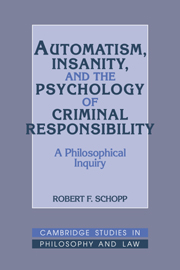3 - Problematic defenses: Automatism
Published online by Cambridge University Press: 07 October 2009
Summary
Automatism is a defense against criminal liability for those defendants who perform illegal conduct in a state of unconsciousness or semi-consciousness. The defense may apply to “behavior performed in a state of mental unconsciousness or dissociation without full awareness”. Although the paradigmatic cases of automatism are those involving convulsions, reflexes, or other movements that are apparently performed without any conscious direction, the defense also applies to those who perform complex actions in coordinated, directed fashion, but with substantially reduced awareness. Courts have recognized the defense in cases in which the defendant's impaired consciousness was associated with epilepsy, somnambulism, concussion, or physical or emotional trauma.
Although relatively rare, the defense has been accepted sufficiently often to establish it as a recognized criminal defense in the United States and Britain. Courts vary widely, however, in their theoretical accounts of the defense. As with the NGRI defense, the difficulties encountered by courts as they attempt to formulate and apply the automatism defense reflect the courts' inability to satisfactorily define the place of this defense in the larger system of offense elements and defenses.
THE AMERICAN APPROACH
American courts have not settled on a consistent interpretation of the automatism defense. Some have treated automatism as a variation of the general excuse of insanity, interpreting epilepsy as a defect of reason that prevented the defendant from knowing the nature and quality of his act.
- Type
- Chapter
- Information
- Automatism, Insanity, and the Psychology of Criminal ResponsibilityA Philosophical Inquiry, pp. 71 - 85Publisher: Cambridge University PressPrint publication year: 1991

